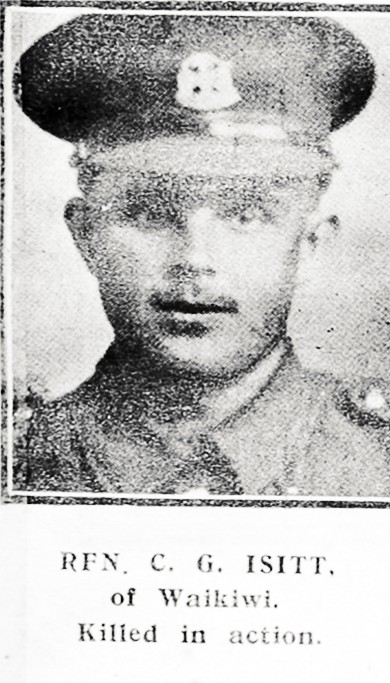Rfn
Caleb George Isitt
Informations sur naissance
|
Date de naissance: 13/11/1893 |
|
Lieu de naissance: Waikiwi, Southland, New Zealand |
Informations générales
|
Profession: Serviteur de la ferme |
Informations service militaire
|
Pays: New Zealand |
|
Force armée: New Zealand Expeditionary Force |
|
Rang: Rifleman |
|
Numéro de service: 40956 |
|
Incorporation date: 30/10/1916 |
|
Incorporation nom de lieu: Invercargill, Southland, New Zealand |
|
Unités: — New Zealand Rifle Brigade, 1st Bn. (Dernière unité connue) |
Informations sur décès
|
Date de décès: 05/12/1917 |
|
Lieu de décès: Reutel, Beselare, Belgique |
|
Cause du décès: Killed in action (K.I.A.) |
|
Âge: 24 |
Cimetière
|
Polygon Wood Cemetery Parcelle: / Rangée: F Tombe: 11 |
Distinctions et médailles 2
|
British War Medal Médaille |
|
Victory Medal Médaille |
Points d'intérêt 3
| #1 | Lieu de naissance | ||
| #2 | Lieu d'enrôlement | ||
| #3 | Lieu du décès (approximatif) |
Mon histoire
Rifleman Caleb George Isitt
Caleb Isitt was born in Waikiwi near Invercargill, New Zealand on 13 November 1893, son of John and Sarah Isitt. He was the oldest of seven children.
When he enlisted in Invercargill on 30 October 1916, Caleb worked as a farm labourer in the Waikiwi area. He joined the 23rd Reinforcement, service number 40956, in a Rifle Brigade training company, at Trentham, Featherston and Tauherenikau camps. The reinforcement embarked from Wellington on the troop ship Ruapehu, on 14 March 1917, arriving in Devonport, England on 21 May.
Caleb trained for a month at Sling Camp before sailing for France on 21 June 1917. He was at Etaples for two weeks before being posted to C Company, 1st Battalion, New Zealand Rifle Brigade on 9 July 1917.
It is not known whether he was directly involved in the actions on 4 and 12 of October 1917. If so, he emerged without incident.
The New Zealand Division was in the Polygon Wood area, after the end of the Third Battle of Ypres. Much of the time was spent in wiring, repairing crumbling trenches and improving defences. The landscape was covered with waterlogged shellholes. The opposing German forces generally held higher ground and movement in the New Zealand lines was often observed and shelled or machine-gunned.
The Division relieved the 21st Division from 13th November, when the 3rd (NZ Rifle Brigade) and 4th NZ Infantry Brigades took over the front line. On 1st December the NZ Rifle Brigade relieved the 4th Infantry Brigade in the Becelaere Sector, with the 1st Battalion ( Caleb’s unit) relieving the 3rd Otago Battalion. The brigade headquarters was at the Polygon Butte.
On 3 December part of 2nd Brigade attacked Polderhoek Chateau, with limited success and heavy casualties. The Rifle Brigade history does not offer much detail on this period so it is difficult to say how Caleb Isitt died on 5 December 1917. There were heavy snow storms during the time.
Caleb was buried in Polygon Wood Cemetery along with others of the NZ Rifle Brigade killed in this period. He is in Row F, Grave 11.
Caleb Isitt was born in Waikiwi near Invercargill, New Zealand on 13 November 1893, son of John and Sarah Isitt. He was the oldest of seven children.
When he enlisted in Invercargill on 30 October 1916, Caleb worked as a farm labourer in the Waikiwi area. He joined the 23rd Reinforcement, service number 40956, in a Rifle Brigade training company, at Trentham, Featherston and Tauherenikau camps. The reinforcement embarked from Wellington on the troop ship Ruapehu, on 14 March 1917, arriving in Devonport, England on 21 May.
Caleb trained for a month at Sling Camp before sailing for France on 21 June 1917. He was at Etaples for two weeks before being posted to C Company, 1st Battalion, New Zealand Rifle Brigade on 9 July 1917.
It is not known whether he was directly involved in the actions on 4 and 12 of October 1917. If so, he emerged without incident.
The New Zealand Division was in the Polygon Wood area, after the end of the Third Battle of Ypres. Much of the time was spent in wiring, repairing crumbling trenches and improving defences. The landscape was covered with waterlogged shellholes. The opposing German forces generally held higher ground and movement in the New Zealand lines was often observed and shelled or machine-gunned.
The Division relieved the 21st Division from 13th November, when the 3rd (NZ Rifle Brigade) and 4th NZ Infantry Brigades took over the front line. On 1st December the NZ Rifle Brigade relieved the 4th Infantry Brigade in the Becelaere Sector, with the 1st Battalion ( Caleb’s unit) relieving the 3rd Otago Battalion. The brigade headquarters was at the Polygon Butte.
On 3 December part of 2nd Brigade attacked Polderhoek Chateau, with limited success and heavy casualties. The Rifle Brigade history does not offer much detail on this period so it is difficult to say how Caleb Isitt died on 5 December 1917. There were heavy snow storms during the time.
Caleb was buried in Polygon Wood Cemetery along with others of the NZ Rifle Brigade killed in this period. He is in Row F, Grave 11.
Sources 4
|
Archives New Zealand https://archway.archives.govt.nz Sources utilisées |
|
Auckland Weekly News http://www.aucklandcity.govt.nz/dbtw-wpd/heritageimages/ Sources utilisées |
|
Austin WL., The official history of the New Zealand Rifle Brigade (The Earl of Liverpool's Own), (Wellington, L.T. Watkins, 1924), pg. 255-258. Sources utilisées |
|
New Zealand births deaths marriages https://www.bdmhistoricalrecords.dia.govt.nz Sources utilisées |
Complément d’informations 5
|
Commonwealth War Graves Commission Database https://www.cwgc.org/find-records/find-war-dead/casualty-details/480036 |
|
Namenlijst (In Flanders Fields Museum) https://namenlijst.org/publicsearch/#/person/_id=c53054da-8b7b-446e-804e-9a2b2b5c9e0a |
|
Lives of the First World War (Imperial War Museum) https://livesofthefirstworldwar.iwm.org.uk/lifestory/7177002 |
|
The NZEF Project (UNSW Canberra) https://nzef.adfa.edu.au/showPerson?pid=127019 |
|
Online Cenotaph (Auckland Museum) https://www.aucklandmuseum.com/war-memorial/online-cenotaph/record/c7538 |
